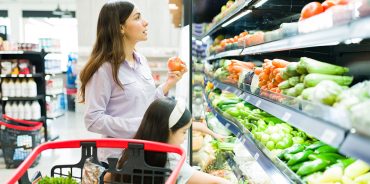An introduction to store media
There’s much more to retail media than just ecommerce. When brands and agencies step into the world of grocery-based media, they gain access to an array of channels that can help them engage with shoppers online, in-store, and beyond. What are those channels, though? How do they work, and what benefits do they bring?
In the first of a series exploring different retail media channels, in-store media experts Ellen Alexander, Odile Tran and Connor Chappell provide an overview of the key store media opportunities at play in the grocery industry today.
From banners to trolley ads, for as long as we’ve had grocery stores, we’ve also had store media. Today, thanks to significant advances in data science and technology, store media is no longer the untargeted, linear medium that it once was. Instead, it’s a nuanced and measurable channel, one in which activities can be deeply tailored in order to reach different audiences and meet specific marketing objectives.
Store media presents brands and media agencies with a powerful advertising opportunity. Some of the many benefits that it offers include:
- The ability to reach large numbers of customers who are already looking to make a purchase.
- Prompting impulse buys, or encouraging customers to switch.
- Calling out pricing, promotions, offers, and other incentives.
- Educating customers about products, particularly newly launched items.
- Linking back to wider brand building initiatives such as Above the Line campaigns.
Let’s take a look at some of the most common store media formats available today – from what they are to how they work.
Printed Point-of-Sale
Just as the name suggests, Printed Point-of-Sale (PPoS) allows brands to run ads in high-impact areas – typically alongside products at the shelf. One of the key advantages of PPoS is that it allows brands to communicate the benefits of the featured SKU at the exact point at which many shoppers are making up their mind about what to buy.
Typical PPoS formats include:
- Banner Dividers – hanging banners that stand out from the shelf.
- Shelf Talkers – printed strips attached to the shelf edge.
- Recipe Pads – brand-sponsored tear-off recipe cards.
Digital Display
Digital screens go by a number of different names – digital display, digital signage, outdoor digital screens are but a few. While the titles may change, though, the general concept remains relatively uniform: Digital Display typically refers to any kind of digital screen placed in or outside of a grocery store. Formats can vary from small, monitor-style screens embedded within an aisle to large, ceiling-hung displays.
Regardless of the format, most screens of this kind are capable of showing either static or animated content. Messaging is normally tailored to the location of the screen and customer behaviours in that specific area; screens at the store entrance may be more appropriate from a brand awareness perspective, for instance, while those situated in a specific aisle can help to point out deals and offers.
Digital Display ad space is usually purchased based on the run-time and duration of individual campaigns, though some retailers and retail media vendors also offer exclusivity deals, allowing brands to “own” selected screens.
Store Radio
Whereas PPoS and Digital Display are both visual mediums, Store Radio focuses on ambient content that helps to highlight products to customers wherever they happen to be. Store Radio channels typically feature a combination of music and short bursts of ad content, making it an effective and subtle way to raise awareness, highlight incentives or promotions, and extend the impact of other media campaigns.
Barcode Scanners
Handheld Barcode Scanners have become an increasingly common sight in many supermarkets, giving customers the ability to scan items as they add them to their baskets, and then pay for them at a dedicated checkout. While it remains a relatively new channel, some innovative retailers now offer advertising opportunities on the handsets themselves.
Unlike the other channels in this list, Barcode Scanners are actually used by customers in the process of completing their shop. As a result, ensuring that advertising doesn’t interfere with that is paramount. Splash ads that disappear after a handset is unlocked, for instance, give brands a chance to engage customers without hindering their shop.
While they aren’t actual channels, no discussion of modern Store Media would be complete with mentioning the issues of targeting and measurement. The proliferation of grocery loyalty cards, in tandem with significant advances in the area of data science, means that brands can now plan and measure their Store Media campaigns much more effectively than they could in the past.
From a targeting perspective, one key opportunity here is the ability to find “predictive audiences” – those customers most likely to buy a product in the future – and focus Store Media campaigns around locations that have the highest numbers of those shoppers. In terms of measurement, loyalty card data can also be used to track sales amongst those shoppers who were exposed to a campaign against those who were not.
In short, while Store Media may be the oldest form of retail media, its evolution continues.
In the next post in this series, we’ll look at the area of onsite media.
TOPICS
RELATED PRODUCTS
Helping brands get the most from retail media
Retail Media & Audience Targeting solutionsMake Retail Media work for your business with Customer Data Science
Retail Media solutionsThe latest insights from our experts around the world


